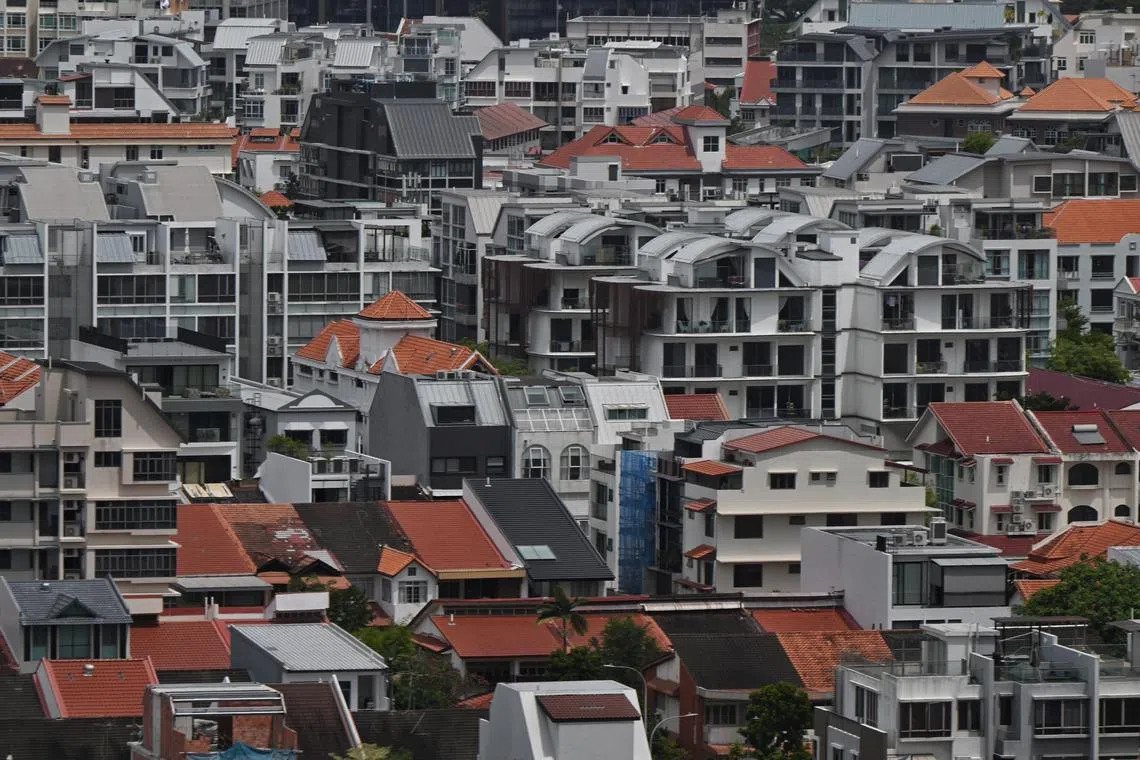New private home prices jumped 3.3% in first quarter, triggering new ABSD hike
Sign up now: Get ST's newsletters delivered to your inbox

Landed property prices jumped 5.9 per cent in the first quarter.
ST PHOTO: KUA CHEE SIONG
Follow topic:
SINGAPORE – Growth in private residential home prices rose 3.3 per cent in the first quarter after a brief moderation in the previous quarter, triggering a new round of property curbs that took effect on Thursday to pre-emptively dampen robust local and foreign investment demand.
The 3.3 per cent rise was slightly higher than the Urban Redevelopment Authority’s (URA) flash estimate of a 3.2 per cent gain,
“Perhaps the Government felt compelled to impose new curbs to ensure that private home prices do not increase further, especially when Singapore’s gross domestic product growth is projected to be lacklustre,” said Knight Frank Singapore head of research Leonard Tay.
This will also buy time for the supply of new homes – 100,000 are expected to be completed between 2023 and 2025
The authorities announced late on Wednesday that the Additional Buyer’s Stamp Duty (ABSD) rate for foreigners purchasing any residential property in Singapore will be raised from 30 per cent to 60 per cent.
For Singapore citizens, the rate will be raised from 17 per cent to 20 per cent for those buying their second residential property, and from 25 per cent to 30 per cent for those getting their third and subsequent property.
Singapore permanent residents (PRs) buying their second residential property will see the rate rise from 25 per cent to 30 per cent, and from 30 per cent to 35 per cent for third and subsequent properties.
Landed property prices jumped 5.9 per cent in the first quarter – the largest quarterly price growth since a 6.7 per cent gain in first quarter 2021. Prices rose 0.6 per cent in fourth quarter 2022.
“A new price record was set in the first quarter, when a terraced house in the Emerald Hill Conservation Area sold at $5,756 psf. This marked a significant 43.5 per cent increase from the previous quarter’s record of $4,010 psf for a terraced house in the Blair Plan Conservation Area,” said Mr Eugene Lim, key executive officer of ERA Realty Network.
Overall, non-landed housing prices gained 2.6 per cent in the first quarter, up from 0.3 per cent in the previous quarter.
Prices in the city fringe posted the fastest growth, jumping 4.4 per cent in the first quarter, up from 3.1 per cent in the previous quarter, due to the launch of Terra Hill in Pasir Panjang. More than a third of Terra Hill’s units were transacted at a median price of $2,695 psf, setting a new benchmark in this sub-market.
Non-landed home prices in the suburbs rebounded 1.9 per cent following a 2.6 per cent drop in the fourth quarter, due to new launches Sceneca Residence and The Botany at Dairy Farm. These two mass-market condos transacted at median prices of $2,084 psf and $2,087 psf respectively.
Prices in the prime district rose just 0.8 per cent in the first quarter, up from 0.7 per cent.
“As the prime district tends to see a higher proportion of foreigner demand, the ABSD hike is expected to affect this sub-market more. Prices here have risen at a slower pace compared to the city fringe and the suburbs, and the ABSD hike will likely crimp further upside,” PropNex chief executive officer Ismail Gafoor said.
Nonetheless, some investors have switched from buying stocks to real estate amid record high rentals, noted PropertyGuru Singapore country manager Tan Tee Khoon.
Citing URA caveat data, he noted that some 100 luxury units in the prime district were picked up by Chinese nationals in the first quarter, up from 43 units in the same period a year ago.
New home sales excluding executive condominiums (ECs) surged to 1,256 units in the first quarter from 690 units in the previous quarter, due to several new launches.
OrangeTee & Tie senior vice-president of research and analytics Christine Sun said new sales may continue to rise as more projects are launched in the coming months. “Some developers may not hold back their launches as first-timers are not hit by the ABSD increase,” she said.
Developers launched 1,312 uncompleted private homes for sale in the first quarter, up from 504 in the fourth quarter.
Slightly fewer resale homes were sold in the first quarter, with the number of homes resold dipping to 2,622 units from 2,694 units in the fourth quarter. Resales made up 63.6 per cent of all private homes sold, compared with 75.1 per cent in the previous quarter.
The rental market rose at a more moderate pace, up 7.2 per cent in the first quarter, compared with 7.4 per cent in the fourth quarter.
Rents of non-landed properties rose 6.2 per cent, against a 7.5 per cent gain previously, while rents of landed properties jumped 14.5 per cent compared with a 6.3 per cent increase in the previous quarter.
In the non-landed market, apartments in the prime district saw the biggest rental hikes at 6.4 per cent, followed by the city fringe at 6.2 per cent and the suburbs at 6.1 per cent.
The rental market is likely to see more demand after the latest property curbs, Huttons Asia senior director of research Lee Sze Teck said.
“It is getting too expensive for Singaporeans to buy a second home. Most of them are likely to sell their first property and rent in the interim. Foreigners are likely to rent while they apply for their permanent residency or citizenship. Rents are estimated to grow around 10 per cent in 2023,” he said.
The Government has been ramping up the supply of private housing. According to the URA, 15,221 units, including ECs, will be completed in the remaining three quarters of 2023, with 21,421 units slated for completion in 2024 and 2025.
In total, about 40,400 units including ECs are expected to be completed between 2023 and 2025, which is around double the 20,000 units completed between 2020 and 2022.


